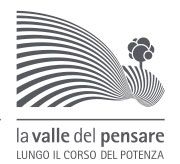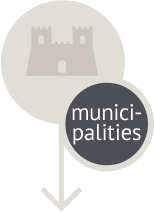GARDEN “VILLA LA QUIETE” OR “VILLA SPADA”
The historical residence “Villa la Quiete”, known by people of Treia as “Villa Spada”, rises up just outside the walls of the city in contrada San Marco Vecchio on a little high ground, from which it is possible to enjoy a beautiful view up to the sea.
Around the residence’s axis of symmetry there are the elements of the garden, of the wood and of the atrium, joined to the analogous theme of trident.
The most elevated area of the complex, totally covered by a linden wood, holm oaks and oaks, is followed by a trident of wide boulevards connected with sinuous ways of English taste. The lateral boulevards guide to “terrazze-belvedere”: the central boulevard goes up to the summit of the hill marked by a circle of 15 holm oaks. The composed fulcrum of the trident is composed by an elegant octagonal exedrawith pointed arches, one time closed by colored glass walls and covered by a copper cap.
The most original surprise of the wood is on the summit of two semicircular opposed handles, where rises up a little temple that, to the stiff shapes of columns similar to simple cylinders, compares the entry forged as a cone log that remind the atriums of Egyptian tombs and that so attest the rapid diffusion of this style in Europe, after the Napoleon Campaign.
The wide oval square in front the Villa is the connection ring together with the atrium that has three converged axis.
Valadier can express major inventive freedom in the surrounding areas where creates, according to the current fashion, two enormous ruins in the entry’s gate and a stable with stiff geometrical forms that remind immediately to Leudox and Boullèe projects.
Rare essences, hundreds and hundreds of flowers boxes spread their fragrances in the vast garden where Lavinio Spada had wanted to lavish liberally the own substances, creating a magical Eden in honor of his life partner, the Polish countess Natalia Komar.
In 1857 Vittorio Amicucci, gardener of Villa Spada, listed in a rare publication the species and varieties cultivated in the garden; the list, edited by Amicucci, includes a striking list of cultivated plants: anemones, azaleas, camellias, chrysanthemums, dahlias, carnations, ixia, roses, verbenas, violets. At that time the variety of dahlias and roses in the garden were hundreds; the collection of camellias overtook 400 varieties, and in 1858 added also collection of palm trees and cycads.
Among trees glimpse also numerous buildings that make Villa Quiete a peculiar place of pleasures; besides the little Egyptian temple, a neo-Gothic aviary and a fish farm obtains from the difference in height of the soil, they create suggestive scenic designs that show the big culture of the knowledgeable costumer.
VILLA SPADA OR VILLA “LA QUIETE”
The historic house “Villa La Quiete”, better known by Treia’s Citizens as “Villa Spada”, is located inside a park of about 29.000,00 sqm that owns some distinctive elements of Valadier’s design. Passing through the Propylaeum topped by ornamental sculptures and crossing the Gothic gate, there is the atrium, which is the entrance of the complex. The hall is formed by three boulevards that are three axes converging to a circle.
It is the only relevant house entirely designed by architect Valadier and it is considered his artistic masterpiece because of “the boldness in combining harmoniously different architectural trends, the imagination in creating the different elevations of the villa and the stable and the ingenuity in finding a natural and elegant solution for the garden."
The design of the house follows, in the essential lines, the ancient "villae" of the Romans, “expression of magnificence, power and wealth”, as Valadier himself defines such residences.
"It was close to town, but lower, stood on a mound of its own. Gates and keeper’s houses were at the bottom and a long tree-lined avenue separated and hid. The villa dedicated to the quiet, aloof but close, had a church dedicated to sorrow. It seemed that everything had been done to be fenced and locked, even the wood, and what widened inside, remained closed to the eye. "
From the novel "Down the square there is no one" of Dolores Prato.
THE HISTORY OF THE HOUSE
According to historic information, the house presents the current aspect from 1810, when the pre-existing convent was suppressed through a Napoleonic edict (the complex is linked to the memory of the Church of San Savino built in 1036, and the Monastery of the Capuchins built in 1579). The building, together with the adjacent plot (vegetable garden and wood), was purchased by Luigi Angelini.
In 1815, Angelini designate the famous neoclassic architect Giuseppe Valadier, who was in Treia to design the Georgic Academy façade, to project a cottage that will be named “Villa La Quiete”. He also designed the structure of the park.
Villa La Quiete had great relevance also in the agricultural experimentation field.
The interest by Treia’s Georgic Academy started, indeed, because inside the Villa there were greenhouses for the study of experimental cultivation.
Over time there have been several owners of the house. In 1853 the property passed to intellectual Lavinio de’ Medici Spada. When he died in 1864, the house was inherited first by the brother Alessandro, then to the nephew Thomas, who finally sold it. The most famous name “Villa Spada”, derives indeed from Spada Counts.
Later, the whole complex was influenced by less favourable times in the town:
- during the II World War it was used as a prison and as a Polish command by the troops supporting the liberation actions;
-from 1960 for 20 years it was used as kindergarten managed by ecclesiastics and then by the Municipality, till 1982, when the unsteady conditions of the building led to evacuation.
By decree of the General Director of the Ministry of Cultural Heritage and Activities of 14 September 2000, pursuant to art. 61 of Legislative Decree n. 490/1999, the Ministry has exercised the right of pre-emption in favor of the Municipality of Treia.
THE LAVINIO DE’ MEDICI SPADA’S REIGN
The central role of Lavinio de’ Medici Spada (an ecletic personality, literature and science expert, but above all an enlightened patron and careful collectionist) in the construction of Villa La Quiete is evident only nowadays. He commissioned the settlement works of the park and its structures, and he decided to call the house “La Quiete”. The whole complex, modified to welcome his interests, reflects his aspirations, hopes and activities.
He was the second son of Conte Girolamo Spada and Giulia de’ Medici. According to the tradition for the nobles without primogeniture rights, he enrolled in the Ecclesiastic Academy of Rome and he quickly got the prelate title from Papa Leon XII. Likely, he did not have true interest in the future ecclesiastic career, even if it rewarded him with prestigious assignments. He never took the votes and soon, in 1848, he left the prelature to marry the beautiful Polish countess Natalia Komar, retire himself to private life and dedicate himself with method and discipline to his precious otium at the House in Treia.
“Forgetting helps me
blessed solitude
let people talk
lonely beatitude”
Those four verses on the fresco of the rib vault covering the terminal southern part of the loggia in front of “La Quiete” building, show how much Lavinio needed his reign. At the same time, this poem, called “The distance”, which Lavinio dedicated to his beloved residence “La Quiete” during his stay in Paris, in 1859, proves how the world outside had become hostile for Lavinio. Actually, he did not merely build a dwelling house but he gave life to his dream, his aspirations and interests. He creates his own universe and designates a solid surrounding wall to protect it. He plans the northern side of the park as a trident, with its centre at the front side of the villa, according to the original installation of the southern forest. Lavinio designed flower and vegetables gardens and he commissioned the construction of a greenhouse in order to host the results of his botanic and floriculture studies, including plants coming from America, Asia and India.
The abbot Emidio Bianchi counts about ten thousands species of plants and flowers cultivated by Lavinio, in particular “a beautiful and assorted family, never seen before in Italy, of Fuchsia, Begonia, Camelia and Pelargonium plants, that attracted the look of the spectators.” He also contributed to the creation of the manor house that rises up in the middle, with the wonderful Valadier design”, characterized by wide inner spaces. Probably, Lavinio assembled, organized and exhibited the collections he accurately composed during his whole life: the scientific collections, such as the mineralogy one (obtained through twenty years of research), and the artwork collections.
The death of his wife, and the consequent decision to burn the lines dedicated to her, are the last acts in the construction of a closed scheme and the creation of the romantic isolation necessary to a man tired of the world. Willing to exclude and forget everything that could unsettle his dear Quiet, he felt obliged to remove the painful memories instilled in those lines, making a sort of physical and spiritual regeneration. Nonetheless, he left an open door to the past, a point of contact with the real world. With fanatic outburst and masochistic nostalgia, he commissioned to construct a small but beautiful Pantheon in memory of his lost wife.
Together with Lavinio’s death in 1864, the “myth” of “La Quiete” becomes eternal and part of a tenaciously desired and meticulously constructed reign. For none of the following owners La Quiete House was a place where to live and dwell.In fact, it was forgot by Alessandro, Lavinio’s brother, and sold by the nephew Thomas. The House, without Lavinio, its master, inevitably declined.








